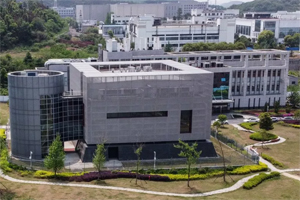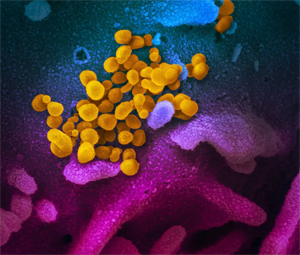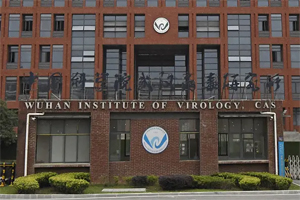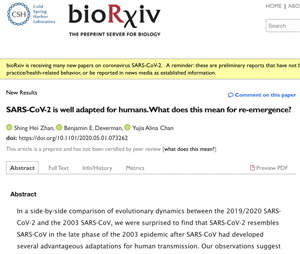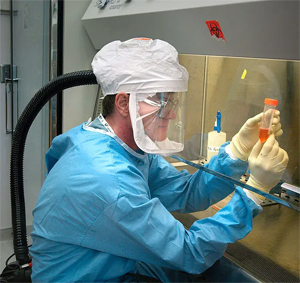The Controversial Experiments and Wuhan Lab Suspected of Starting the Coronavirus Pandemic
by Fred Guterl, Naveed Jamali and Tom O'Connor
Newsweek
4/27/20 AT 3:34 PM EDT
NOTICE: THIS WORK MAY BE PROTECTED BY COPYRIGHT
YOU ARE REQUIRED TO READ THE COPYRIGHT NOTICE AT THIS LINK BEFORE YOU READ THE FOLLOWING WORK, THAT IS AVAILABLE SOLELY FOR PRIVATE STUDY, SCHOLARSHIP OR RESEARCH PURSUANT TO 17 U.S.C. SECTION 107 AND 108. IN THE EVENT THAT THE LIBRARY DETERMINES THAT UNLAWFUL COPYING OF THIS WORK HAS OCCURRED, THE LIBRARY HAS THE RIGHT TO BLOCK THE I.P. ADDRESS AT WHICH THE UNLAWFUL COPYING APPEARED TO HAVE OCCURRED. THANK YOU FOR RESPECTING THE RIGHTS OF COPYRIGHT OWNERS.
The Wuhan Lab Remains A Suspect In the Coronavirus Investigation
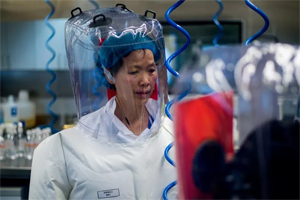
The coronavirus pandemic may be a result of controversial experiments inside the Wuhan Institute of Virology, as U.S. intelligence now concedes. Chinese virologist Shi Zhengli inside the P4 laboratory in Wuhan, China, on February 23, 2017. JOHANNES EISELE/AFP VIA GETTY IMAGES
Just one day after the U.S. surpassed China to become the country with the highest number of Covid-19 cases, the U.S. Defense Intelligence Agency updated its assessment of the origin of the novel coronavirus to reflect that it may have been accidentally released from an infectious diseases lab, Newsweek has learned.
The report, dated March 27 and corroborated by two U.S. officials, reveals that U.S. intelligence revised its January assessment in which it "judged that the outbreak probably occurred naturally" to now include the possibility that the new coronavirus emerged "accidentally" due to "unsafe laboratory practices" in the central Chinese city of Wuhan, where the pathogen was first observed late last year. The classified report, titled "China: Origins of COVID-19 Outbreak Remain Unknown," ruled out that the disease was genetically engineered or released intentionally as a biological weapon.
"We have no credible evidence to indicate SARS-CoV-2 was released intentionally or was created as a biological weapon," the report found. "It is very unlikely that researchers or the Chinese government would intentionally release such a dangerous virus, especially within China, without possessing a known and effective vaccine." Every scientist interviewed by Newsweek for this story also rejected categorically the notion that the virus was intentionally released.
Covid-19 has infected nearly 3 million people across the globe, initially ravaging China before hitting hardest in the West and leaving the United States as the most deeply-afflicted country, with more than 55,000 deaths as of April 27. Its origin remains the subject of not only scientific debate, but a politically charged dispute in the international community.
Citing academic literature, the DIA document states that a "definitive answer may never be known" as to how the disease truly first emerged. A U.S. intelligence spokesperson told Newsweek, "the Intelligence Community has not collectively agreed on any one theory."
Uncertain Source
Tracing the origin of a new virus is not easy. It took researchers at the Wuhan Institute more than a decade to trace the 2002-2003 SARS virus to remote bat caves in Yunnan province. It's not surprising, then, that in early February, China's Academy for Military Medical Sciences "concluded that it was impossible for them to scientifically determine whether the Covid-19 outbreak was caused naturally or accidentally from a laboratory incident," according to the DIA document.
Initial assessments conducted by the Chinese government pointed to the city's Huanan Seafood Market as the likely cause of a natural outbreak of SARS-CoV-2, a new coronavirus that causes Covid-19. In the early days of the outbreak, local officials played down the possibility of human-to-human transmission of the virus and silenced doctors who spoke out about the growing outbreak. It may have undercounted deaths and the number of cases of Covid-19. A spurious theory that the U.S. deliberately planted the virus in Wuhan also started circulating.
China's foreign ministry told reporters April 23rd that the World Health Organization found "no evidence" the outbreak started at the Wuhan laboratory, and Yuan Zhiming, vice president of the Wuhan Institute of Virology and president of the Chinese Academy of Sciences Wuhan Branch, blasted the inference of intentional misuse or creation as "malicious" and "impossible."
"The director of the Galveston National Laboratory in the United States made it clear that our laboratory is just as well managed as labs in Europe and the U.S.," he said. "I think it is understandable for people to make that association. But it is a malicious move to purposefully mislead the people" to think that the virus escaped from [our Wuhan] labs.
"They have no evidence or logic to support their accusations. They are basing it completely on their own speculations."
The DIA report, however, cites U.S. government and Chinese researchers that found "about 33 percent of the original 41 identified cases did not have direct exposure" to the market. That, along with what's known of the laboratory's work in past few years, raised reasonable suspicion that the pandemic may have been caused by a lab error, not the wet market.
Here's what the scientific and circumstantial evidence shows.
Back in 2002, when SARS emerged in China's Guandong province, it served as a wake-up call. Over the next few decades, the U.S., China and other nations poured money into efforts to hunt down and catalogue strange new pathogens that live in wild animals and figure out how much of a threat they pose to humans, with the goal of preventing the next devastating pandemic.
In the fall of 2019, the SARS-CoV-2 coronavirus emerged in the middle of the large, cosmopolitan city of Wuhan. Chinese officials at first insisted that the virus, SARS-CoV-2, could be caught only through direct contact with animals. But many of the early patients in Wuhan had no connection to the wild animal markets, which meant that the virus had already been spreading from person to person. When this fact came out, it cast doubt on the veracity of information coming from China, but the virus was well on its way to becoming a deadly pandemic.
In the early days, the prevailing theory of the virus' origins was that it, like SARS, arose in bats, passed to some other mammal such as a pangolin, and ultimately entered the population through the wild-animal markets.
By March, the wild-virus theory was still the most likely explanation of the origin of SARS-CoV-2--but it was starting to look a little ragged around the edges. For one thing, the Wuhan Institute of Virology, not far from the animal markets in downtown Wuhan, houses the world's largest collection of coronaviruses from wild bats, including at least one virus that bears a resemblance to SARS-CoV-2. What's more, Wuhan Institute of Virology scientists have for the past five years been engaged in so-called "gain of function" (GOF) research, which is designed to enhance certain properties of viruses for the purpose of anticipating future pandemics. Gain-of-function techniques have been used to turn viruses into human pathogens capable of causing a global pandemic.
This is no nefarious secret program in an underground military bunker. The Wuhan lab received funding, mostly for virus discovery, in part from a ten-year, $200 million international program called PREDICT, funded by the U.S. Agency for International Development and other countries. Similar work, funded in part by the U.S. National Institutes of Health, has been carried out in dozens of labs throughout the world. Some of this research involves taking deadly viruses and enhancing their ability to spread quickly through a population— research that took place over the objections of hundreds of scientists, who have warned for years of the program's potential to cause a pandemic.
In the years since the SARS outbreak, many instances of mishaps involving the accidental release of pathogens have taken place in labs throughout the world. Hundreds of breaches have occurred in the U.S., including a 2014 release of anthrax from a U.S. government lab that exposed 84 people. The SARS virus escaped from a Beijing lab in 2004, causing four infections and one death. An accidental release is not complicated and doesn't require malicious intent. All it takes is for a lab worker to get sick, go home for the night, and unwittingly spread the virus to others.
The Wuhan Institute has a record of shoddy practices that could conceivably lead to an accidental release, as officials at the U.S. Embassy in Beijing reportedly warned in a cable on January 19, 2018. "During interactions with scientists at the WIV laboratory, they noted the new lab has a serious shortage of appropriately trained technicians and investigators needed to safely operate this high-containment laboratory," states the cable, according to the Washington Post.
Two years before the novel coronavirus pandemic upended the world, U.S. Embassy officials visited a Chinese research facility in the city of Wuhan several times and sent two official warnings back to Washington about inadequate safety at the lab, which was conducting risky studies on coronaviruses from bats. The cables have fueled discussions inside the U.S. government about whether this or another Wuhan lab was the source of the virus — even though conclusive proof has yet to emerge.
In January 2018, the U.S. Embassy in Beijing took the unusual step of repeatedly sending U.S. science diplomats to the Wuhan Institute of Virology (WIV), which had in 2015 become China’s first laboratory to achieve the highest level of international bioresearch safety (known as BSL-4). WIV issued a news release in English about the last of these visits, which occurred on March 27, 2018. The U.S. delegation was led by Jamison Fouss, the consul general in Wuhan, and Rick Switzer, the embassy’s counselor of environment, science, technology and health. Last week, WIV erased that statement from its website, though it remains archived on the Internet.
What the U.S. officials learned during their visits concerned them so much that they dispatched two diplomatic cables categorized as Sensitive But Unclassified back to Washington. The cables warned about safety and management weaknesses at the WIV lab and proposed more attention and help. The first cable, which I obtained, also warns that the lab’s work on bat coronaviruses and their potential human transmission represented a risk of a new SARS-like pandemic.
“During interactions with scientists at the WIV laboratory, they noted the new lab has a serious shortage of appropriately trained technicians and investigators needed to safely operate this high-containment laboratory,” states the Jan. 19, 2018, cable, which was drafted by two officials from the embassy’s environment, science and health sections who met with the WIV scientists. (The State Department declined to comment on this and other details of the story.)
The Chinese researchers at WIV were receiving assistance from the Galveston National Laboratory at the University of Texas Medical Branch and other U.S. organizations, but the Chinese requested additional help. The cables argued that the United States should give the Wuhan lab further support, mainly because its research on bat coronaviruses was important but also dangerous.
As the cable noted, the U.S. visitors met with Shi Zhengli, the head of the research project, who had been publishing studies related to bat coronaviruses for many years. In November 2017, just before the U.S. officials’ visit, Shi’s team had published research showing that horseshoe bats they had collected from a cave in Yunnan province were very likely from the same bat population that spawned the SARS coronavirus in 2003.
“Most importantly,” the cable states, “the researchers also showed that various SARS-like coronaviruses can interact with ACE2, the human receptor identified for SARS-coronavirus. This finding strongly suggests that SARS-like coronaviruses from bats can be transmitted to humans to cause SARS-like diseases. From a public health perspective, this makes the continued surveillance of SARS-like coronaviruses in bats and study of the animal-human interface critical to future emerging coronavirus outbreak prediction and prevention.”
The research was designed to prevent the next SARS-like pandemic by anticipating how it might emerge. But even in 2015, other scientists questioned whether Shi’s team was taking unnecessary risks. In October 2014, the U.S. government had imposed a moratorium on funding of any research that makes a virus more deadly or contagious, known as “gain-of-function” experiments.
As many have pointed out, there is no evidence that the virus now plaguing the world was engineered; scientists largely agree it came from animals. But that is not the same as saying it didn’t come from the lab, which spent years testing bat coronaviruses in animals, said Xiao Qiang, a research scientist at the School of Information at the University of California at Berkeley.
“The cable tells us that there have long been concerns about the possibility of the threat to public health that came from this lab’s research, if it was not being adequately conducted and protected,” he said.
There are similar concerns about the nearby Wuhan Center for Disease Control and Prevention lab, which operates at biosecurity level 2, a level significantly less secure than the level-4 standard claimed by the Wuhan Insititute of Virology lab, Xiao said. That’s important because the Chinese government still refuses to answer basic questions about the origin of the novel coronavirus while suppressing any attempts to examine whether either lab was involved.
Sources familiar with the cables said they were meant to sound an alarm about the grave safety concerns at the WIV lab, especially regarding its work with bat coronaviruses. The embassy officials were calling for more U.S. attention to this lab and more support for it, to help it fix its problems.
“The cable was a warning shot,” one U.S. official said. “They were begging people to pay attention to what was going on.”
No extra assistance to the labs was provided by the U.S. government in response to these cables. The cables began to circulate again inside the administration over the past two months as officials debated whether the lab could be the origin of the pandemic and what the implications would be for the U.S. pandemic response and relations with China.
Inside the Trump administration, many national security officials have long suspected either the WIV or the Wuhan Center for Disease Control and Prevention lab was the source of the novel coronavirus outbreak. According to the New York Times, the intelligence community has provided no evidence to confirm this. But one senior administration official told me that the cables provide one more piece of evidence to support the possibility that the pandemic is the result of a lab accident in Wuhan.
“The idea that it was just a totally natural occurrence is circumstantial. The evidence it leaked from the lab is circumstantial. Right now, the ledger on the side of it leaking from the lab is packed with bullet points and there’s almost nothing on the other side,” the official said.
As my colleague David Ignatius noted, the Chinese government’s original story — that the virus emerged from a seafood market in Wuhan — is shaky. Research by Chinese experts published in the Lancet in January showed the first known patient, identified on Dec. 1, had no connection to the market, nor did more than one-third of the cases in the first large cluster. Also, the market didn’t sell bats.
Shi and other WIV researchers have categorically denied this lab was the origin for the novel coronavirus. On Feb. 3, her team was the first to publicly report the virus known as 2019-nCoV was a bat-derived coronavirus.
The Chinese government, meanwhile, has put a total lockdown on information related to the virus origins. Beijing has yet to provide U.S. experts with samples of the novel coronavirus collected from the earliest cases. The Shanghai lab that published the novel coronavirus genome on Jan. 11 was quickly shut down by authorities for “rectification.” Several of the doctors and journalists who reported on the spread early on have disappeared.
On Feb. 14, Chinese President Xi Jinping called for a new biosecurity law to be accelerated. On Wednesday, CNN reported the Chinese government has placed severe restrictions requiring approval before any research institution publishes anything on the origin of the novel coronavirus.
The origin story is not just about blame. It’s crucial to understanding how the novel coronavirus pandemic started because that informs how to prevent the next one. The Chinese government must be transparent and answer the questions about the Wuhan labs because they are vital to our scientific understanding of the virus, said Xiao.
We don’t know whether the novel coronavirus originated in the Wuhan lab, but the cable pointed to the danger there and increases the impetus to find out, he said.
“I don’t think it’s a conspiracy theory. I think it’s a legitimate question that needs to be investigated and answered,” he said. “To understand exactly how this originated is critical knowledge for preventing this from happening in the future.”
-- State Department cables warned of safety issues at Wuhan lab studying bat coronaviruses, by Josh Rogin, The Washington Post, April 14, 2020
To be sure, there's no evidence that SARS-Cov-2 came from the Wuhan lab, nor that the virus is the product of engineering.
To discover exactly how to attack SARS-CoV-2 safely and efficiently, our vaccine candidate Biovacc-19 was designed by first carefully analysing the biochemistry of the Spike. We ascertained that it is highly unusual in several respects, unlike any other CoV in its clade. The SARS-CoV-2 general mode of action is as a co-receptor dependent phagocyte. But data shows that simultaneously it is capable of binding to ACE2 receptors in its receptor binding domain. In short, SARS-CoV-2 is possessed of dual action capability. In this paper we argue that the likelihood of this being the result of natural processes is very small. The spike has six inserts which are unique fingerprints with five salient features indicative of purposive manipulation. We then add to the bio-chemistry a diachronic dimension by analysing a sequence of four linked published research projects which, we suggest, show by deduction how, where, when and by whom the SARS-CoV-2 Spike acquired its special characteristics. This reconstructed historical aetiology meets the criteria of means, timing, agent and place to produce sufficient confidence to reverse the burden of proof. Henceforth, those who would maintain that the Covid-19 pandemic arose from zoonotic transfer need to explain precisely why this more parsimonious account is wrong before asserting that their evidence is persuasive, most especially when, as we also show, there are puzzling errors in their use of evidence...
The co-receptor dependent phagocytic general method of action for infectivity and pathogenicity of SARS-CoV-2 appears to be specifically related to cumulative charge resulting from inserts placed on the surface of the Spike receptor binding domain, right next to the receptor binding motif. That SARS-CoV-2 has charged inserts is not in dispute (Zhou et al., 2020) What we have shown that is new is that the SARS-CoV-2 Spike carries significant additional charge (isoelectric point (pI) pI=8.2) compared to human SARS-CoV Spike,( pI = 5.67) and the implications thereof. Basic domains -- partly inserted, partly substituted amino acids and partly redistributed from outside the receptor binding domain -- explain the salt bridges formed between the SARS-CoV-2 Spike and its co-receptors on the cell membrane...
To recapitulate Fig 2 from our vaccine paper, there are 6 inserts which make the SARS-CoV-2 Spike structurally special. They are unique fingerprints of the SARS-CoV-2 Spike which deserve to be highlighted in support of this view; and there are five salient features that strengthen the case for purposive manipulation in the laboratory....1. A major part of the spike protein has human-like domains with matured transmission adaption. Blasting the Spike protein with a rolling window of 6 amino acids showed that 78.4% of 6 amino acid windows are human like. This means that with nearly 80% of the spike protein has a built-in stealth property by having high human similarity. Therefore, it is remarkably well-adapted virus for human co-existence. Such high human similarity also implies a high risk for the development of severe adverse events/toxicity and even Antibody Dependent Enhancement (ADE) unless specific precautions are taken when using the Spike protein in any vaccine candidate: precautions that might not suggest themselves to designers employing conventional methodologies and innocent assumptions about the target virus, lacking our detailed anatomisation of it. Furthermore and significantly, Zhan et al also note that, surprisingly, this characteristic is present from the very first isolate (Zhan et al, 2020). This is something that does not sit well with an hypothesis of natural evolution.
2. The Spike displays new amino acid inserts with condensed cumulative charge, all of which are surface exposed (please refer to the reproduced figure from the vaccine paper, above). This is a most significant finding as we mentioned in opening. Being physically located on the surface of the Spike protein greatly increases the infectivity and pathogenicity of the virus, enabling these inserts to participate in binding to co-receptors/negatively charged attachment receptors or even, as we have discovered, to the negatively charged phospholipid heads on the cell membrane. Such a result is typically the objective of gain of function experiments to create chimeric viruses of high potency. Therefore this is a strong indicator of manipulation.
3. The concentration of positive charge is on the receptor binding domain near the receptor binding motif at the top of the Spike protein. As with (2) this is more elegantly explained by an hypothesis of purposive manipulation than one of natural evolution. As can be seen in Figure 2 (side view) of the Spike trimer, the majority of the positive charged amino acids are located near or on the top of the spike protein giving the receptor binding domain a pI=8.906, while the Cov-2 specific Cys538-Cys590 bridge brings in additional charge from 526-560 (with even higher pI=10.03) via the Cys391-Cys525 to positions right next to the receptor binding motif (where the ACE2 receptor is located). It is this which facilitates the dual mode capability, allowing binding to ACE2 and/or to co-receptors/attachments receptors. We posit that such ACE2 independent attachment and infectivity is happening and is evidenced clinically by the Covid-19 disease pattern. It is also reported by Zhou et al (2018). The receptors that are the most likely to be involved are CLEC4M/DC-SIGN (CD209) – see discussion point (5) below.
4. The Spike is so configured that it can bind to cell tissue without use of the ACE2 receptor. Clinically it is widely observed that the Covid-19 virus compromises the functions of olfaction and bitter/sweet receptors, erythrocytes, t-cells, neurons and various tissues such as intestine epithelia. These different targets do not engage and use ACE2 receptor binding. The concentration of high positive charge in and around the top of the Spike protein and the potential to use opposite charged attachment-/co-receptors can facilitate binding and infection in the general mode of action for infectivity that we published in detail in QRBD. In 2018 Zhou P et.al. 2018 found that a new Corona virus which they named SADS (Swine Acute Diarrhoea Syndrome) could infect the intestine and kill piglets without use of ACE2, aminopeptidase N (APN) or dipeptidyl peptidase 4 (DPP4) receptors.[9] We have done a blast analysis of the SADS Spike S1 protein and could find no trace of ACE2 RBM. The significance of this will become clear in the next point and the next section.
5. Location and concentration of charge on the attachment receptor CLEC4M/DC-SIGN (C-type Lectin domain family 4 member M (CLEC4M)/ Dendritic Cell-Specific Intercellular adhesion molecule-3-Grabbing Non-integrin(DC-SIGNR) also known as CD209) (Marzi et al., 2004). Analysis of the CLEC4M attachment receptor shows an overall pI=5.23 where the C-type lectin tail 274-390 has a pI=4.4. However, due to the two disulfide bonds Cys296-Cys389 and Cys368-Cys381 the C-terminal part of the tail is pulled back to a domain around position 296. This condensed negatively charged domain is ready for formation of salt-bridges with similar condensed opposite charged amino acids structures on the S1 RBD of SARS-CoV-2. This finding is fascinating and significant for a different reason to the others. It is not about Spike manipulation itself: in the next section we will explain that and how we believe that these capabilities were developed between 2008 - 2015. This finding points to something else: a trial to demonstrate a newly discovered attachment/co-receptor by field testing and verification. The context was the 2018 Swine Acute Diarrhoea Syndrome (SADS) outbreak in Guangzhou province.[10] Assuming that the Wuhan Institute of Virology team had discovered the functionalities of CLEC4M/DC-SIGN/CD209 receptors in the new SADS-CoV isolate and the fact that it could bind to positive charge (Ref: https://www.uniprot.org/uniprot/Q9NNX6 (CD209) and https://www.uniprot.org/uniprot/Q9H2X3) and that they wanted to do a field test of the described functionalities, the best conditions for doing so would be in connection with an ongoing viral infection. If this SADS originally did not have a ACE2 receptor binding motif (RBM), then a binding capacity verification of these attachment receptors could be done straightforwardly. But if SADS did have an ACE2 RBM, then it would be necessary to remove or disable the RBM of the Spike protein on this CoV isolate and execute the experiment in piglets including the formal Cox postulate verification of infection as described in the 2018 paper.
We postulate that there are 2 charged domains on SADS that are likely to contribute to attachment receptor binding located in domains 330-360 and 540-560 respectively. Recollect that we have identified a similar highly charged structure on SARS-CoV-2 within the edge of the RBD domain (526-560) with pI=10.03 which is brought right into the core of the RBD (to approximately position 400) by Cys-Cys bridging of the domain (538-590). This domain can contribute binding similar to that which can be observed for SADS. This new Cys-Cys property inserted into the SARS-CoV-2 Spike does not exist in SARS-CoV and hence could not provide such charge enhancement onto the RBD and co-receptor binding by natural evolution.
A sequence of four linked research papers is explained
A comprehensive review of the relevant literature shows that a substantial amount of directly relevant gain-of function research has been undertaken. Four studies are especially noteworthy. They are linked in two ways: scientifically, in that the third and fourth build upon the results of the first and second, and in continuity of the institution and personnel across all four. The Wuhan Institute of Virology is a key collaborator in all these projects and Dr Zheng-Li Shi is one of the Institute's most experienced virologists and bat specialists. She is a common thread through all the key research projects...1. In 2008, Dr Shi was in the team whose research was an enabling pre-cursor to the two linked gain-of-function projects which lead to SARS-CoV-2's exact functionalities, including functionalities discovered via SADS and potentially field-tested in the 2018 study as suggested above. The 2008 Ren W et al project successfully demonstrated technical capabilities to interchange RBD’s between bat SARS-like and human SARS viruses: “... a minimal insert region (amino acids 310 to 518) was found to be sufficient to convert the SL-CoV S from non-ACE2 binding to human ACE2 binding, indicating that the SL-CoV S is largely compatible with SARS-CoV S protein both in structure and in function. The significance of these findings in relation to virus origin, virus recombination, and host switching is discussed" (Ren et al, 2008). Dr Shi is next a lead author of the second paper in this sequence, (Hou et al, 2010) and a co-author and the senior Chinese author of the third, (Menachery et al, 2015). She is also a co-author of the fourth (Zhou P. et al, 2018)
2. In 2010 scientists from the 'Special Viruses' section of the Wuhan Institute of Virology were engaged in 'gain of function' experiments, jointly with international collaborators, to increase SARS-CoV infectiousness for humans. They used an HIV pseudo virus to express seven bat ACE2 receptors and compared their binding properties to human ACE2 receptors in order to pick the best for further optimizing a SARS-like coronavirus’s ability to bind to human cells. They also found that some bat ACE2 receptors are very close to human ACE2 receptors. This study provided a model system for testing the most infectious of SARS-CoV-like viruses which already had been selected in a vast survey of Chinese bat populations between 2005 – 2013.(Xu L et al, 2016). These viruses were potentially infectious to humans via the ACE2 receptor. Further new viruses were identified between 2012-2015 (Lin et al,2017).
3. In 2015 scientists from the 'Special Viruses' section of the Wuhan Institute of Virology were engaged in 'gain of function' experiments jointly with a majority team from the University of North Carolina Chapel Hill. Together, they manipulated bat viruses to create a mouse adapted chimeric virus SHC014-MA15 which binds to and can proliferate on human upper airway cells (2B4 Calu-3 -- a cell line contributed by Chapel Hill): ("group 2b viruses encoding the SHC014 spike in a wild type backbone can efficiently utilize multiple ACE2 receptor orthologs, replicate efficiently in primary human airway cells, and achieve in vitro titers equivalent to epidemic strains of SARS-CoV"). We suggest that it is a high priority in further investigations to ascertain precisely from Chapel Hill lab records the exact donor provenance of 2B4 Calu-3. The lead Wuhan scientist, who provided the CoV material, was Dr Zheng-Li Shi ("provided SHC014 spike sequences and plasmids"). We note that what is described here are, in fact, precisely SARS-CoV-2 properties. In vivo experiments at Chapel Hill replicated the chimeric virus in mouse lung which showed significant pathogenesis which was the opposite of what the team had expected ("the creation of chimeric viruses like SHC014-MA15 was not expected to increase pathogenicity"). Menachery et al reported that it may be hard to develop a vaccine against SHC014-MA15. We can see, therefore, that the 2015 experiment advanced the 2010 work by perfecting in animal trials a virus optimised to infect the human upper respiratory tract. The 2015 authors were well aware that the chimeric virus which they had created was very dangerous because they discussed this fact. Of the opportunity/costs of their research, they suggested that “while offering preparation against future emerging viruses, this approach must be considered in the context of the US government-mandated pause on Gain Of Function (GOF) studies” (which has since been lifted). They also speculated that "review panels may deem similar studies too risky to pursue as increased pathogenicity in mammalian models cannot be excluded." It is certainly the case that this experiment created a chimeric virus with very high infectivity potential targeted to the human upper respiratory tract. Yet a surprising observation is that the paper states that this research consortium has permission to continue this research. It appears that optimisation gain of function work on this chimeric virus did continue. We deduce from paper authorships that this was done in the Wuhan Institute of Virology.
4. In 2018, as discussed earlier, Dr Shi's close colleague Peng Zhou, with others, investigated a coronavirus outbreak associated with a fatal Swine Acute Diarrhoea Syndrome (SADS) in Guangdong Province. This paper relates that piglets had a tissue specific infection site located in the intestine and that verification of the Bat Covid nature of this new SADS as the disease-causing agent was confirmed. 25,000 piglets died. However, the really interesting part of this study reports that in order to identify the receptor(s) used by the SADS CoV, known coronavirus host cell receptors were investigated: Angiotensin Converting Enzyme 2 (ACE2), Amino Peptidase N (APN), and Di-Peptidyl Peptidase 4 (DPP4). None of these receptors worked. But indirectly in their paper, the authors revealed their ability to express and to test new receptors in the ways posited earlier. Recollect that the model to do this was proven and reported in the 2010 work. Thus it is plain that SADS is a CoV infection utilising new tissue-specific binding domains; but the authors provide no hint about which receptor the virus is using in piglets except that it is not any of the best known three. We have offered our deduction above. Pigs, of course, have immune systems very similar to humans....
[W]e next observed that in the Covid-19 pandemic, a well-reported symptom in the early phase of the infection is loss of taste, headache and a sore throat. We have discussed this issue in the QRBD article in detail. But to summarise: in 2015 in a research review (Workman et al, 2015) discussed bitter/sweet taste receptors and the role these receptors play in mediating airway immune functions. They concluded thus: "Over the past several years, taste receptors have emerged as key players in the regulation of innate immune defenses in the mammalian respiratory tract. Several cell types in the airway, including ciliated epithelial cells, solitary chemosensory cells, and bronchial smooth muscle cells, all display chemoresponsive properties that utilize taste receptors."
Therefore we hypothesise the reconstructed historical aetiology of the Spike as follows:
In 2008, Dr Zheng-Li Si and WIV colleagues successfully demonstrated technical capabilities to interchange RBD’s between bat SARS-like and human SARS viruses. Building upon this, the 2010 work (Hou et al, 2010) perfected the ability to express receptors on human cells. On these foundations, the central Gain of Function work that underpins the functionalities of SARS-CoV-2 took place, carrying the WIV spike and plasmid materials to bond successfully to a UNC Chapel Hill human epithelial cell-line. This work (Menachery et al) produced a highly infectious chimeric virus optimised to the human upper respiratory tract. In convergent support of this hypothesis, both Lu (Lu et al, 2020) and Jia (Jia et al, 2020) have now, in January and April 2020, shown that SARS-CoV-2 has a bat SARS-like backbone but is carrying an RBD from a human SARS and Zhan et al have, like us, noted unusual adaption to humans from the first isolate. In the 2015 Chapel Hill work it was only ACE2 receptors that were discussed. However, in 2018 Zhou P. et al demonstrated capabilities to clone other receptors like APN and DPP4 and to test and compare these against the (intestine) tissue specific SADS-CoV identified. Then, in the 2019-20 Covid-19 pandemic, profuse symptoms indicating compromise of the bitter/sweet receptors are reported. Taken all together, this implies that by employing insights gained after 2015, as just deduced, a further optimization of the 2015 chimeric virus for additional binding to receptors/co-receptors such as bitter/sweet specific upper airway epithelia receptors occurred. That would help to explain the otherwise puzzling high infectivity and pathology associated with SARS-CoV-2 and hence also help to explain the social epidemiology of its spread.
-- The Evidence which Suggests that This Is No Naturally Evolved Virus: A Reconstructed Historical Aetiology of the SARS-CoV-2 Spike, by Birger Sørensen, Angus Dalgleish & Andres Susrud
Most scientists believe, based on the evidence available, that a natural origin is the most likely explanation. But neither have they ruled out these possibilities. "At this stage, it is not possible to determine precisely the source of the virus which caused the COVID-19 pandemic," says the World Health Organization in a statement to Newsweek. "All available evidence suggests that the virus has a natural animal origin and is not a manipulated or constructed virus."
The circumstantial evidence is strong enough to warrant putting the lab's programs and practices at the heart of the investigation. And it's worth looking anew at whether scientists, in their efforts to protect the public from the threat of natural pathogens, overreached.

